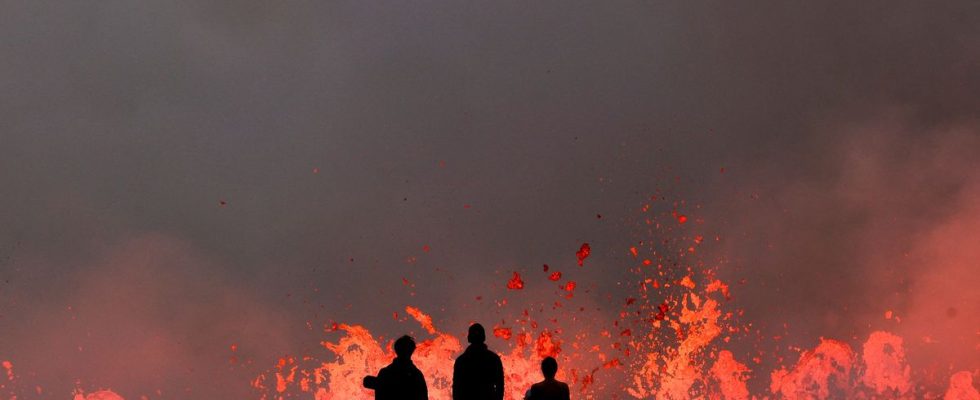A “pure orange like the sun” magma. A few tourists, attracted like butterflies to the flame, came to observe these large lava flows escaping from faults almost a kilometer long. Despite calls from authorities to avoid visiting the site of the new eruption in Iceland southwest of Reykjavik, intrepid people defied the ban.
If the eruption remains “low intensity” according to volcanologists, the first estimates indicate that its flow is significantly more powerful than the two previous eruptions in 2021 and 2022 on the Reykjanes peninsula, an area where lava has returned since. two years after eight centuries in slumber. “On this side, with the wind going in the opposite direction, it’s not that hot. It’s okay, it’s like a campfire. But when you come to the other side, with the gases, the heat is unbearable. Much too hot to stay there for a second too long. It feels like 1,000 degrees,” said Niall Lynch, a 23-year-old Irish guide.
“High and dangerous” pollution
Located 30 kilometers as the crow flies from Reykjavik, the new eruptive faults reached a total size of around 900 meters during the night, against 200-300 meters initially according to the latest point from the Icelandic Meteorological Institute (IMO ), around 5 a.m., Tuesday morning. “When you look at the core of the lava flow, it’s much brighter than I expected. I thought I was seeing darker colors, black and brown, like when the rock solidifies. But in the middle it’s a pure orange like the sun. It’s incredible, ”says Niall.
Gas pollution, in particular sulfur dioxide, “is high and dangerous” on the site, warned the IMO, which advises tourists not to go there before more precise estimates and closes access to the site. around 11 p.m. Monday night. During the six months of the March 2021 eruption, then the three weeks of the August 2022 eruption, hundreds of thousands of visitors came to admire the hypnotic spectacle of the lava, relatively easy to access from Reykjavik on the outskirts of Mount Fagradallsfjall and the valleys of Meradalir and Geldingadalir.
An “indescribable” feeling
Unlike explosive eruptions spitting out thousands of tons of dust, such as the still famous one at Eyjafjallajökull which paralyzed air traffic in Europe in 2010, so-called “effusive” eruptions have little impact, apart from lava flows and local toxic gas peaks. The handful of visitors who managed to reach the site before it closed describe the experience of a lifetime.
From the nearest road, you have to take a difficult path, the last three kilometers of which are winding through moss and rocks embedded in the ground. When finally the lava is in sight, with the small mount Litli Hrutur (“little ram”) on the left, the feeling is “indescribable”, confides Jessica Poteet, a 41-year-old American who lives in Iceland.
A miracle of a few days or several months?
“When you go up the hill for the first time, especially since it’s the first day, you see the lava fountains and you hear the cracking of the hardening rock. It’s just amazing,” she says. “It’s really great to break away from your daily routine, to come and connect with the Earth and nature in this way”, abounds Gudmundur Hauksson, a 26-year-old Icelander who also came among the first.
When the wind doesn’t blow it away, the powerful smell evokes that of “a big barbecue”, according to some visitors. Down near the lava, we are also seized by a thick smoke linked not to the gases but to the foam all around the site which ignites and burns under the 1,200 ° C of the molten liquid. How long will this natural spectacle last, destined to become the attraction for the hundreds of thousands of tourists who come to visit Iceland in this season? “We have no idea,” says volcanologist Thorvaldur Thordarson of the University of Iceland. “It can last a few days, a month, six months like in 2021 or even longer than that.”

